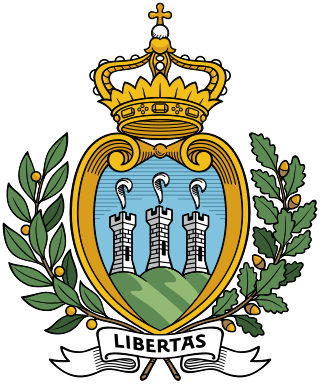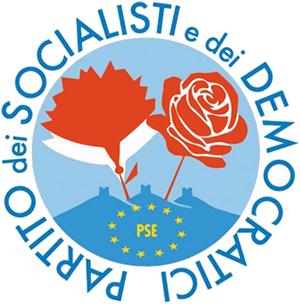
San Marino, officially the Republic of San Marino and also known as the Most Serene Republic of San Marino, is a European microstate and enclave within Italy. Located on the northeastern side of the Apennine Mountains, it is the fifth-smallest country in the world, with a land area of just over 61 km2 and a population of 33,660 as of 2022.
As the only surviving medieval commune in the Italian Peninsula, the history of San Marino is intertwined with the medieval, Renaissance and modern-day history of the Italian peninsula, according to tradition beginning with its foundation in 301 AD.

The Sammarinese Christian Democratic Party is a Christian-democratic political party in San Marino.

The Sammarinese Socialist Party was a socialist and, later, social-democratic political party in San Marino. Its Italian counterpart was the Italian Socialist Party and its international affiliation was with the Socialist International.

Captains Regent are the two heads of state of the Republic of San Marino. They are elected every six months by the Grand and General Council, the country's legislative body. Normally the Regents are chosen from parties in coalition and serve a six-month term. The investiture of the Captains Regent takes place on 1 April and 1 October every year. This tradition dates back at least to 1243.

The Sammarinese Communist Party was a Marxist political party in the small European republic of San Marino. It was founded in 1921 as a section of the Communist Party of Italy (PCI). The organization existed for its first two decades as an underground political organization.
The Sammarinese Independent Democratic Socialist Party was a social-democratic political party in San Marino. Its Italian counterpart was the Italian Democratic Socialist Party.

The Party of Socialists and Democrats is a social-democratic and democratic socialist political party in San Marino. It is a member of the Socialist International, and observer member of the Party of European Socialists. It is the only Sammarinese party with a reference to the European Union in its official political symbol. Its current-day Italian counterpart is the Democratic Party.

The Grand and General Council is the parliament of San Marino. The council has 60 members elected for a five-year term.

The New Socialist Party was a social-democratic political party in San Marino.

This page list topics related to San Marino.

Rovereta is a village (curazia) in San Marino. It belongs to the municipality (castello) of Serravalle. Its name, in Italian language, refers to a wood of "Sessile Oaks".

General elections were held in San Marino on 4 March 1923 to elect the seventh term of the Grand and General Council. It was a snap election that marked the beginning of fascist rule in the republic. Left-wing parties were prevented from participating, while all centre-right forces ran as a single "Patriotic Bloc". Of the 60 seats, 29 were taken by the Sammarinese Fascist Party, 20 by the Sammarinese People's Party, 9 by the Sammarinese Democratic Union and two by the Fascist-puppets Volunteers of War. Later the country was taken over by the Fascist Party.

General elections were held in San Marino on 12 December 1926 to elect the eighth term of the Grand and General Council. It was a sham election, all opposition being prevented to participate by internal and Italian threats. After it had taken over the country in April 1923, the Sammarinese Fascist Party was the only party to contest the elections, winning all 60 seats, while the official report spoke of a sole dissident ballot. A new electoral law guaranteed safe undisputed seats to the two incumbent Captains Regents.

Italy and San Marino have had diplomatic relations since Italian unification. Bilateral relations between Italy and San Marino have gone through various phases and have their official beginning after the Unification of Italy proclaimed in the Subalpine Parliament by Vittorio Emanuele II on 17 March 1861.

Women in San Marino are European women who live in or are from the Republic of San Marino. Sammarinese women currently share almost all social and political rights with men in San Marino.

The Committee of Freedom was a political alliance in San Marino.

The Popular Alliance was a political alliance in San Marino.
Clara Boscaglia was a Sammarinese politician. One of the first women to be elected to the Grand and General Council, she later became the first in San Marino to serve as a government minister.
Milena Gasperoni is a Sammarinese politician who is one of two Captain Regent for San Marino since April 2024 and serving alongside Alessandro Rossi.










